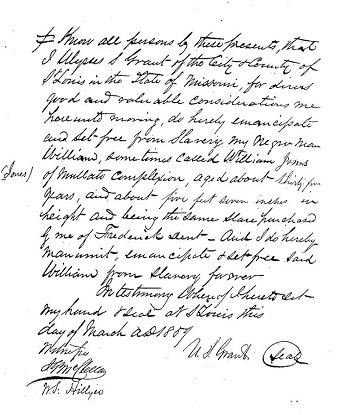Last updated: April 26, 2020
Person
William Jones

Missouri Historical Society
William Jones was an enslaved man owned by Ulysses S. Grant for a period of time in the late 1850s. On March 29, 1859, Grant went to the St. Louis Courthouse and wrote a manumission paper legally freeing Jones from slavery. Jones is the last enslaved person to have been owned by a U.S. President.
A lack of documentation makes it difficult to trace most of Jones's life experiences. According to his manumission paper, Jones was born around 1824, five foot seven in height, and of mulatto complexion (a nineteenth century term for someone who is of mixed black and white ancestry). For a number of years he lived and worked on the White Haven plantation in St. Louis, Missouri, which was owned by Grant's father-in-law, Frederick F. Dent. Grant purchased Jones from his father-in-law while working as a farmer at White Haven (1854-1859). The exact date of this purchase is unknown. Jones may have assisted in the construction of Grant's log cabin on the property, "Hardscrabble," and most likely worked on eighty acres of White Haven land that was managed by Grant and cultivated for fruit and vegtable crops.
After continued setbacks and financial struggles at White Haven, Grant gave up farming and moved to downtown St. Louis in early 1859 to work in real estate. Had Grant chosen to do so, he could have sold Jones for a profit of $1,000 to $1,500 (more than $43,000 in 2020 dollars) to a prospective slaveholder in St. Louis. Instead, he chose to give Jones his freedom.
Park staff at Ulysses S. Grant National Historic Site are currently working to learn more about Jones's whereabouts after he received his freedom. Two possible theories exist at this time. The first is that he may have remained in St. Louis. A St. Louis City Directory for 1860 includes a listing for a "William Jones (Col'd)" who was living with five other free people of color in an outbuilding along the city riverfront. The listing also states that this person was working as a horse driver. The second theory is that he may have moved to California. George W. Dent, a brother-in-law of Ulysses S. Grant, moved to that state in the early 1850s and brought along Henrietta, an enslaved woman at White Haven (even though slavery was banned in California). Grant's wife Julia recalled later in life that while traveling through San Francisco in 1879, she was called upon by a Henrietta Jones who remembered Julia from their days together at White Haven. The "Jones" surname has led to speculation that Henrietta may have been married to William. Alternatively, the similar surname could have represented a sibling or other familial relation between the two, or Henrietta's marriage to a different person with the last name of Jones. Regardless, these theories remain purely speculative at this time.
